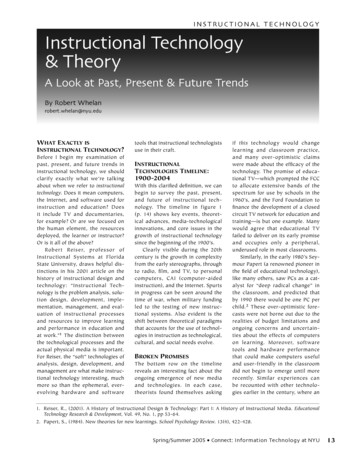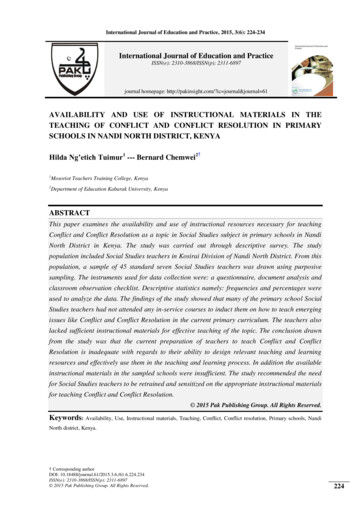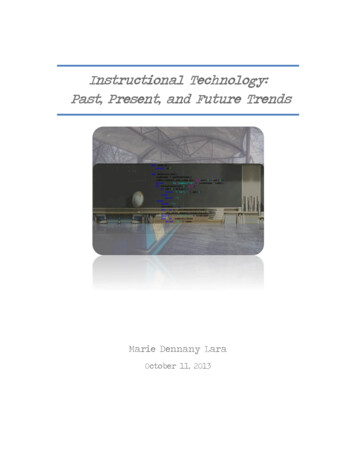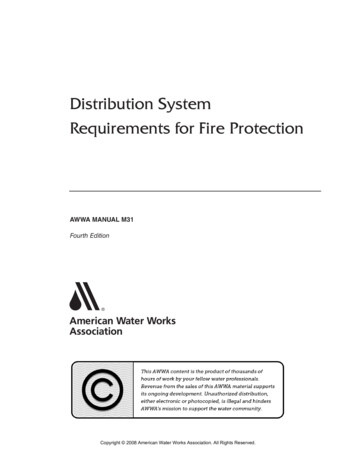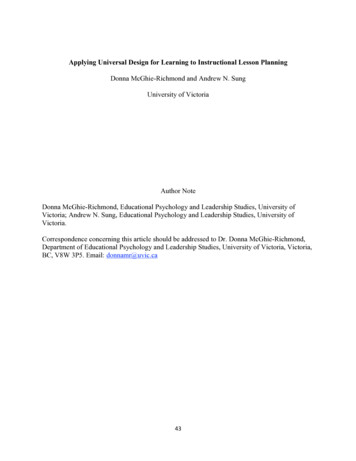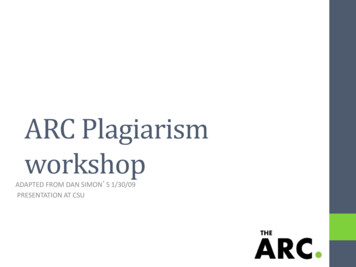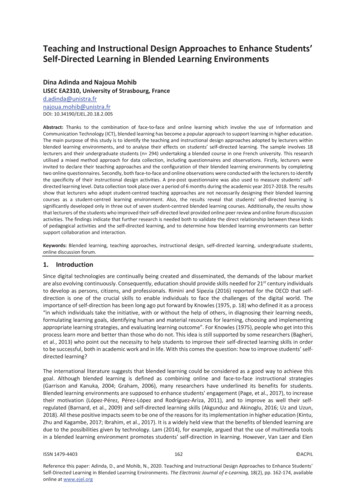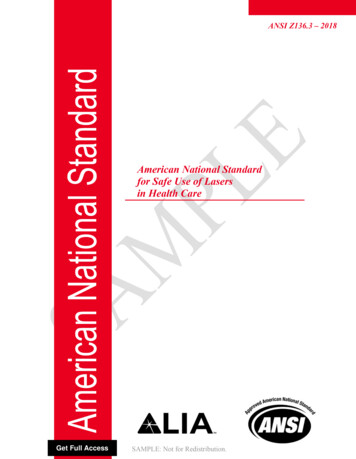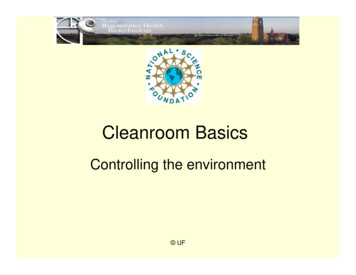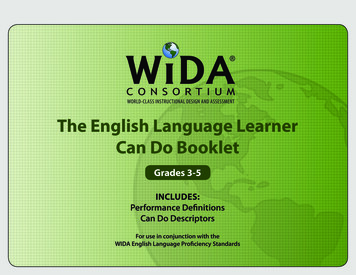
Transcription
WORLD-CLASS INSTRUCTIONAL DESIGN AND ASSESSMENTThe English Language LearnerCan Do BookletGrades 3-5INCLUDES:Performance DefinitionsCan Do DescriptorsFor use in conjunction with theWIDA English Language Proficiency Standardsi
Copyright Notice 2012 Board of Regents of the University of Wisconsin System. The WIDA English Language Learner Can Do Booklet, Grades 3-5, may notbe reproduced, modified, or distributed without prior written permission from the WIDA Consortium. The WIDA ELL Can Do Booklet isfor your personal, noncommercial use only. Fair use of the WIDA ELL Can Do Booklet includes reproduction for the purpose of teaching(including multiple copies for lesson planning).To order more copies of this booklet, please visit www.wida.us or contact the WIDA Help Desk at toll free 1-866-276-7735 or e-mailhelp@wida.us. 2012 Board of Regents of the University of Wisconsin System, on behalf of the WIDA Consortium—www.wida.us.
Foreword: The WIDA English Language Learner Can Do BookletThe WIDA Consortium, from its conception, envisioned a system of standards and assessments that would assistschools in teaching academic language to English Language Learners (ELLs). This dream, now a reality, includesthe development of practical tools to guide teachers when designing and implementing lessons, monitoring studentprogress, determining student language proficiency levels, collaborating across programs, and conveying results toELLs and their parents.The WIDA English Language Learner Can Do Booklet is a very important contribution to meeting these goals. Thebooklet complements the WIDA English Language Proficiency Standards and provides a valuable set of resourcesaligned to the Performance Definitions for the levels of English language proficiency. WIDA’s professionaldevelopment program works with these resources to assist teachers in embedding academic English into contentlessons and working school-wide to ensure the academic success of our culturally and linguistically diverse learners.The WIDA Consortium recognizes that as a teacher of ELLs, you have a challenging but crucial job within yourschool. We sincerely hope that this booklet and other WIDA resources help to make your work more effective andyour students more successful both in learning English and mastering challenging academic content.Timothy Boals, Ph.D.Executive DirectorWIDA Consortium1
2IntroductionThe resources contained in this booklet are intended to support classroom instruction. As with all WIDA products and services, theyaddress language proficiency in relation to five English language proficiency (ELP) standards: Social and Instructional LanguageThe Language of Language ArtsThe Language of MathematicsThe Language of ScienceThe Language of Social StudiesThe following table displays the major components of WIDA’s standards-based system. The bold-faced components are included in thisbooklet and listed in the order in which they appear.Components of WIDA’s Standards-based SystemStandards-based ComponentDistinguishing FeatureStrands of Model Performance Indicators asrepresentative of the WIDA English LanguageProficiency StandardsIllustrate how English language learners process and use language for each Englishlanguage proficiency standard, language domain, and language proficiency levelby grade level clusterPerformance DefinitionsOutline how English language learners process and use language for each level oflanguage proficiency in grades K-12Can Do DescriptorsDescribe how English language learners process and use language for each languagedomain and level of language proficiency by grade level clusterSpeaking and Writing RubricsDocument how English language learners process and use language in the domainof speaking or writing for each level of language proficiency based on three criteria:linguistic complexity, vocabulary usage, and language control in grades K-12
The resources contained in this booklet are intended to supportclassroom instruction. The Performance Definitions (see page 4)provide criteria that shape each of the six levels of English languageproficiency. The three bullets within each proficiency level in thePerformance Definitions represent: Linguistic Complexity —the amount and quality of speechor writing for a given situation Vocabulary Usage—the specificity of words or phrases for agiven context Language Control—the comprehensibility of thecommunication based on the amount and types of errorsThe Performance Definitions provide a concise, global overview oflanguage expectations for each level of English language proficiency.They span the spectrum of grade levels which means that educatorsmust interpret the meaning of the Definitions according to students’cognitive development due to age, their grade level, their diversity ofeducational experiences, and any diagnosed learning disabilities (ifapplicable). For example, in level 5, “extended oral or writtendiscourse” would probably be indicated by a 1st grade student’sability to orally retell a story in a series of sentences using simpletransition words. However, a middle school student might beexpected to exhibit linguistic complexity at level 5 by incorporatinga variety of sentence structures in an essay several paragraphs inlength. It is important to recognize that the Performance Definitionsare the basis for use of other standards-based resources such as theCan Do Descriptors.The Can Do Descriptors (see pages 6-7) are the centerpiece ofthis booklet, designed to support teachers by providing themwith information on the language students are able to understandand produce in the classroom. What is unique about the CanDo Descriptors is that they apply to all five English languageproficiency standards, which means they provide an opportunity tolink language development across all academic content areas. TheDescriptors are intended to be used in tandem with the PerformanceDefinitions. This is because the quantity and quality of languageexpected at a particular level of language proficiency may not befully indicated within the Can Do Descriptor for each languagedomain and proficiency level.For example, the Can Do Descriptors show that students maybe able to “identify” at various levels of language proficiency,but the language (linguistic complexity, vocabulary usage, andlanguage control) they use will vary tremendously. At one end ofthe spectrum, beginning English language learners may identify bypointing or using short words or phrases, whereas at the end of thelanguage development continuum, students will begin to identifycomplex themes and ideas described in detailed technical language.3
4Performance Definitions for the Levels of English LanguageProficiency in Grades K-12At the given level of English language proficiency, English language learners will process, understand, produce, or use:6Reaching specialized or technical language reflective of the content areas at grade level a variety of sentence lengths of varying linguistic complexity in extended oral or written discourse as required by the specified grade level oral or written communication in English comparable to English-proficient peers5Bridging specialized or technical language of the content areas a variety of sentence lengths of varying linguistic complexity in extended oral or written discourse, including stories, essays, or reports oral or written language approaching comparability to that of English-proficient peers when presented with grade-level material4Expanding specific and some technical language of the content areas a variety of sentence lengths of varying linguistic complexity in oral discourse or multiple, related sentences, or paragraphs oral or written language with minimal phonological, syntactic, or semantic errors that do not impede the overall meaning of thecommunication when presented with oral or written connected discourse with sensory, graphic, or interactive support3Developing general and some specific language of the content areas expanded sentences in oral interaction or written paragraphs oral or written language with phonological, syntactic, or semantic errors that may impede the communication, but retain much of itsmeaning, when presented with oral or written, narrative, or expository descriptions with sensory, graphic, or interactive support2Beginning general language related to the content areas phrases or short sentences oral or written language with phonological, syntactic, or semantic errors that often impede the meaning of the communication whenpresented with one- to multiple-step commands, directions, questions, or a series of statements with sensory, graphic, or interactive support1Entering pictorial or graphic representation of the language of the content areas words, phrases, or chunks of language when presented with one-step commands, directions, WH-, choice, or yes/no questions, or statementswith sensory, graphic, or interactive support oral language with phonological, syntactic, or semantic errors that often impede meaning when presented with basic oral commands, directquestions, or simple statements with sensory, graphic, or interactive support
Grade Level ClusterCan Do DescriptorsThe grade level cluster Can Do Descriptors have been created byteachers, primarily for teachers, who work with English languagelearners throughout the consortium. During 2007-08, over 900teachers and administrators participated in refining and validatingfive grade level clusters of Descriptors from the original documentspanning the K-12 spectrum. These Descriptors for the fourlanguage domains—listening, speaking, reading, and writing—andfive levels of English language proficiency are based on the WIDAEnglish Language Proficiency Standards.Interpretation of the Can Do DescriptorsTo maintain the succinctness of the individual statements, somebasic assumptions need to be made in interpreting the Can DoDescriptors.1. Sensory, graphic, or interactive support are present throughlanguage proficiency level 4, Expanding.2. English language learners can process or produce thelanguage associated with the stated language functions.3. Linguistic complexity, vocabulary usage, and language controlincrease incrementally as students move from one Englishlanguage proficiency level to the next.Uses for the Can Do DescriptorsThe Can Do Descriptors are a resource, in addition to the Englishlanguage proficiency standards, to use in classrooms with Englishlanguage learners. As an instructional assessment tool, languageteachers may: Share the Descriptors with classroom teachers andadministrators to describe the second language acquisitionprocess around the levels of English language proficiency Provide resource teachers, such as Title I or literacy coaches,additional information about English language learners Use to plan with tutors or mentors who work with Englishlanguage learners Develop or co-develop lessons and units of study withdifferentiated language objectives Set language goals with their English language learners* Explain to parents students’ progress in listening, speaking,reading, and writing* Suggest language goals to be incorporated into IndividualEducation Programs (IEPs) for English language learners withdiagnosed disabilities Translate English language proficiency test scores (i.e.,ACCESS for ELLs , W-APT , and WIDA MODEL ) intoclassroom practice Observe and note levels of student performance as a precursorto using WIDA Speaking and Writing Rubrics for formativeassessment Use the Descriptors to advocate on behalf of English languagelearnersThe Can Do Descriptors are a sampling of the language expectationsof English language learners as they travel along the continuumof English language development. Unlike the strands of modelperformance indicators that scaffold across levels of languageproficiency, the Can Do Descriptors function independently within * For these uses, the Can Do Descriptors are also available in Spanish on pp. 8-11 ofa given level of language proficiency.this booklet.5
6Can Do Descriptors: Grade Level Cluster 3-5For the given level of English language proficiency and with visual, graphic, or interactive support through Level 4, Englishlanguage learners can process or produce the language needed to:Level 1EnteringSPEAKING Follow one-step oraldirections (e.g., physicallyor through drawings) Categorize content-basedpictures or objects fromoral descriptions Arrange pictures or objectsper oral informationLevel 3DevelopingLevel 4ExpandingLevel 5Bridging Follow multi-step oraldirections Interpret oral informationand apply to new situations Identify illustrated mainideas from paragraph-leveloral discourse Carry out oral instructionscontaining grade-level,content-based language Identify illustrated mainideas and supporting details Construct models or usefrom oral discoursemanipulatives to problemsolve based on oral Infer from and act on oraldiscourseinformation Distinguish between literal Role play the work ofand figurative language inauthors, mathematicians,oral discoursescientists, historians fromoral readings, videos, or Form opinions of people,multi-mediaplaces, or ideas from oralscenarios Identify objects, figures, Follow two-step oralpeople from oral statementsdirectionsor questions (e.g., “Which Draw in response to oralone is a rock?”)descriptions Match classroom oral Evaluate oral informationlanguage to daily routines(e.g., about lunch options) Match literal meanings oforal descriptions or oralreading to illustrations Express basic needs orconditions Answer simple contentbased questions Answer opinion questionswith supporting details Justify/defend opinions orexplanations with evidence Re/tell short stories orevents Discuss stories, issues, andconcepts Make predictions orhypotheses from discourse Give content-based oralreports Give content-basedpresentations usingtechnical vocabulary Offer solutions to socialconflict Offer creative solutions toissues/problems Present content-basedinformation Compare/contrastcontent-based functionsand relationships Name pre-taught objects,people, diagrams, orpictures Recite words or phrasesfrom pictures of everydayobjects and oral modeling Answer yes/no and choicequestions Ask simple, everydayquestions (e.g., “Who isabsent?”) Restate content-based facts Describe pictures, events,objects, or people usingphrases or short sentences Share basic socialinformation with peers Sequence pictures fromoral stories, processes, orprocedures Engage in problem-solvingLevel 6 - ReachingLISTENING Point to stated pictures,words, or phrasesLevel 2Beginning Sequence steps in gradelevel problem-solving Explain in detail resultsof inquiry (e.g., scientificexperiments)The Can Do Descriptors work in conjunction with the WIDA Performance Definitions of the English language proficiency standards. The Performance Definitions use threecriteria (1. linguistic complexity; 2. vocabulary usage; and 3. language control) to describe the increasing quality and quantity of students’ language processing and use across thelevels of language proficiency.
Can Do Descriptors: Grade Level Cluster 3-5For the given level of English language proficiency and with visual, graphic, or interactive support through Level 4, Englishlanguage learners can process or produce the language needed to:Level 1Entering Match icons or diagramswith words/concepts Make sound/symbol/wordrelations Match illustrated words/phrases in differingcontexts (e.g., on theboard, in a book)WRITING Label objects, pictures, ordiagrams from word/phrasebanksLevel 3Developing Identify facts and explicitmessages from illustratedtext Interpret informationor data from charts andgraphs Find changes to root wordsin context Identify main ideas andsome details Identify elements of storygrammar (e.g., characters,setting) Sequence events in storiesor content-based processes Follow visually supportedwritten directions (e.g.,“Draw a star in the sky.”) Use context clues andillustrations to determinemeaning of words/phrasesLevel 4Expanding Classify features of variousgenres of text (e.g., “andthey lived happily everafter” —fairy tales) Match graphic organizersto different texts (e.g.,compare/contrast withVenn diagram) Find details that supportmain ideas Differentiate between factand opinion in narrativeand expository text Make lists from labels orwith peers Produce simple expositoryor narrative text Take notes using graphicorganizers Communicate ideas bydrawing Complete/producesentences from word/phrase banks or walls String related sentencestogether Summarize content-basedinformation Copy words, phrases, andshort sentences Fill in graphic organizers,charts, and tables Compare/contrast contentbased information Answer oral questions withsingle words Make comparisons usingreal-life or visuallysupported materials Author multiple forms ofwriting (e.g., expository,narrative, persuasive) frommodels Describe events, people,processes, procedures Explain strategies or useof information in solvingproblemsLevel 5Bridging Summarize informationfrom multiple relatedsources Answer analytical questionsabout grade-level text Identify, explain, and giveexamples of figures ofspeech Draw conclusions fromexplicit and implicit textat or near grade level Produce extended responsesof original text approachinggrade levelLevel 6 - ReachingREADING Identify cognates from firstlanguage, as applicableLevel 2Beginning Apply content-basedinformation to newcontexts Connect or integratepersonal experiences withliterature/content Create grade-level stories orreportsThe Can Do Descriptors work in conjunction with the WIDA Performance Definitions of the English language proficiency standards. The Performance Definitions use threecriteria (1. linguistic complexity; 2. vocabulary usage; and 3. language control) to describe the increasing quality and quantity of students’ language processing and use across thelevels of language proficiency.7
8Descripción de Habilidades: Grados Escolares 3-5Dado el nivel de desempeño en inglés y apoyados de gráficos, apoyos visuales, y apoyos interactivos hasta el Nivel 4, losestudiantes de inglés pueden procesar o producir el lenguaje que se necesita para hacer lo siguiente:Nivel 1Entrando Señalar dibujos, palabras,o frases según lo indicadoESCUCHAR Identificar objetos, figuras,o personas siguiendodeclaraciones verbaleso preguntas (ejemplo:“¿Cuál de estos objetos esuna piedra?”) Emparejar lenguaje oraldel salón de clase conrutinas diarias Categorizar dibujos decontenido u objetossiguiendo instruccionesverbales Acomodar dibujosu objetos segúninformación oral Seguir instruccionesverbales de dos pasos Hacer dibujos querespondan a instruccionesverbales Evaluar información oral(ejemplo: las opcionespara el almuerzo)Nivel 3Desarrollando Seguir instruccionesverbales de múltiples pasos Identificar las ideasprincipales ilustradas endiscurso verbal a nivel depárrafos Emparejar significadosliterales con ilustracionessiguiendo descripcionesverbales o leídas Ordenar dibujos decuentos, procesos o pasosoralesNivel 4Extendiendo Interpretar informaciónoral y aplicarla asituaciones nuevas Identificar puntosy detalles ilustradosprincipales a través dediscurso oral Inferir y actuar en relacióna información oral Hacer actuaciones delas obras o el trabajo deautores, matemáticos,científicos o historiadoresaprendidos a travésde videos, lecturas omultimediaNivel 5Conectando Seguir instrucciones oralesque contienen lenguaje decontenido académico delgrado escolar Hacer modelos o usarobjetos interactivos pararesolver problemas endiscurso oral Distinguir entre lenguajeliteral y figurativo endiscurso oralNivel 6 - Alcanzando Seguir instrucciones oralesde un paso (ejemplo:físicamente o a través dedibujos)Nivel 2Emergiendo Formarse opiniones depersonas, lugares, o ideasde escenarios presentadosoralmenteLos Descriptores Can Do trabajan en conjunto con Las Descripciones WIDA de las Habilidades en los niveles de lenguaje académico de las normas de desempeño dellenguaje inglés, los cuales usan tres criterios (1. complejidad lingüística; 2. uso de vocabulario; y 3. control del lenguaje) para describir la calidad y la cantidad incremental delprocesamiento y uso de lenguaje a través de los diferentes niveles de desempeño.
Descripción de Habilidades: Grados Escolares 3-5Dado el nivel de desempeño en inglés y apoyados de gráficos, apoyos visuales, y apoyos interactivos hasta el Nivel 4, losestudiantes de inglés pueden procesar o producir el lenguaje que se necesita para hacer lo siguiente:Nivel 1Entrando Expresar necesidades ocondiciones básicasHABLAR Recitar palabras o frasesde dibujos de objetos de lavida diaria y de modelospresentados oralmente Contestar preguntasde selección multiple ypreguntas de sí o no Hacer preguntas simplescotidianas (ejemplo:“¿Quién falto hoy aclases?”) Reformular hechos decontenido académico Describir dibujos, eventos,objetos o personas usandofrases u oraciones cortas Compartir informaciónbásica social con suscompañerosNivel 3DesarrollandoNivel 4ExtendiendoNivel 5Conectando Contestar preguntassimples de contenidoacadémico Contestar preguntas deopinión con detalles queapoyen un argumento Justificar/defenderopiniones o explicacionescon apoyo de evidencia Recontar/contar cuentoscortos o eventos Hablar acerca de cuentos,asuntos y conceptos Predecir algo o hacer unhipótesis por medio deejecutar un discurso Dar presentaciones oralesde contenido académico Dar presentaciones concontenido académicousando vocabulariotécnico Ofrecer soluciones paraconflicto social Presentar información concontenido académico Participar en la resoluciónde problemas Ofrecer solucionescreativas para resolverasuntos/problemas Comparar/Contrastarrelaciones y funciones concontenido académico Ordenar en secuencialos pasos para resolverproblemas según el gradoescolarNivel 6 - Alcanzando Nombrar objetos,personas, diagramas, odibujos que han sido preenseñadosNivel 2Emergiendo Explicar resultadosen detalles de unainvestigación (ejemplo:experimento científico)Los Descriptores Can Do trabajan en conjunto con Las Descripciones WIDA de las Habilidades en los niveles de lenguaje académico de las normas de desempeño dellenguaje inglés, los cuales usan tres criterios (1. complejidad lingüística; 2. uso de vocabulario; y 3. control del lenguaje) para describir la calidad y la cantidad incremental delprocesamiento y uso de lenguaje a través de los diferentes niveles de desempeño.9
10Descripción de Habilidades: Grados Escolares 3-5Dado el nivel de desempeño en inglés y apoyados de gráficos, apoyos visuales, y apoyos interactivos hasta el Nivel 4, losestudiantes de inglés pueden procesar o producir el lenguaje que se necesita para hacer lo siguiente:Nivel 2EmergiendoNivel 3DesarrollandoNivel 4Extendiendo Emparejar íconos odiagramas con palabras/conceptos Identificar hechos omensajes específicos de untexto ilustrado Interpretar información odatos de cuadros o de ungráfico Identificar cognados dellenguaje nativo, según seapliquen Encontrar cambios a laraíz de un palabra en uncontexto específico Identificar las ideasprincipales y algunosdetalles Clasificar característicasde varios géneros de texto(ejemplo: “y vivieronfelices para siempre” –cuentos de hadas) Hacer conexiones consonido/símbolos/palabras Identificar elementosde un cuento (ejemplo:personajes, lugar) Odenar eventos de uncuento o procesos decontenido académico Seguir instruccionesescritas con apoyosvisuales (ejemplo: “Dibujauna estrella en el cielo”) Usar pistas del contextoe ilustraciones paradeterminar el significadode palabras/frases Emparejar palabras/frasesilustradas en diferentescontextos (ejemplo: en lapizarra, en un libro) Emparejar organizadoresgráficos con diferentestextos (ejemplo:comparar/contrastar conun diagrama de Venn) Encontrar detallesque apoyen las ideasprincipales Diferenciar entre unhecho y una opinión enun texto narrativo o en untexto expositivoNivel 5Conectando Resumir informaciónde diferentes orígenesrelacionados entre sí Contestar preguntasanalíticas acerca de textoal nivel del grado escolar Identificar, explicar y darejemplos de elementos dellenguaje retórico Sacar conclusiones de untexto explícito o implícitoal nivel de grado o cercadel nivel de grado escolarNivel 6 - AlcanzandoLEERNivel 1EntrandoLos Descriptores Can Do trabajan en conjunto con Las Descripciones WIDA de las Habilidades en los niveles de lenguaje académico de las normas de desempeño dellenguaje inglés, los cuales usan tres criterios (1. complejidad lingüística; 2. uso de vocabulario; y 3. control del lenguaje) para describir la calidad y la cantidad incremental delprocesamiento y uso de lenguaje a través de los diferentes niveles de desempeño.
Descripción de Habilidades: Grados Escolares 3-5Dado el nivel de desempeño en inglés y apoyados de gráficos, apoyos visuales, y apoyos interactivos hasta el Nivel 4, losestudiantes de inglés pueden procesar o producir el lenguaje que se necesita para hacer lo siguiente:Nivel 1EntrandoESCRIBIRNivel 3DesarrollandoNivel 4ExtendiendoNivel 5Conectando Hacer listas de etiquetascon compañeros Crear un texto narrativo oexpositivo simple Tomar notas usandoorganizadores gráficos Escribir texto original alnivel de grado escolar Comunicar ideas a travésde dibujos Completar/produciroraciones usando bancosde palabras o frases Unir oracionesrelacionadas Resumir información concontenido académico Copiar palabras, frases yoraciones cortas Completar organizadoresgráficos, cuadros o tablas Comparar/Contrastarinformación concontendido académico Contestar preguntas oralescon una palabra Hacer comparacionesusando materiales de lavida real o apoyos visuales Crear múltiples formasde escritura siguiendoun modelo (ejemplo:texto narrativo, textopersuasivo) Aplicar información concontenido académico anuevos contextos Describir eventos,personas, procesos o pasos Explicar estrategias o eluso de información pararesolver problemas Conectar o integrarexperiencias personalescon contenido/literatura Crear informes o cuentosal nivel de grado escolarNivel 6 - Alcanzando Etiquetar objetos, dibujos,o diagramas usandobancos de palabras o frasesNivel 2EmergiendoLos Descriptores Can Do trabajan en conjunto con Las Descripciones WIDA de las Habilidades en los niveles de lenguaje académico de las normas de desempeño dellenguaje inglés, los cuales usan tres criterios (1. complejidad lingüística; 2. uso de vocabulario; y 3. control del lenguaje) para describir la calidad y la cantidad incremental delprocesamiento y uso de lenguaje a través de los diferentes niveles de desempeño.11
2012 Board of Regents of the University of Wisconsin System, on behalf of the WIDA Consortiumwww.wida.us12
Can Do Descriptors. The Can Do Descriptors (see pages 6-7) are the centerpiece of this booklet, designed to support teachers by providing them with information on the language students are able to understand and produce in the classroom. What is unique about the Can Do De

